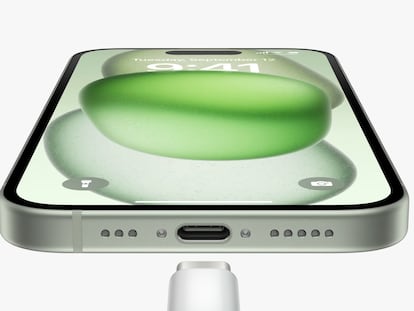How many photos and applications do you have on your mobile? Tricks to end digital clutter
Deleting blurry or duplicate images and making backup copies helps you regain control of your devices

Dozens of applications that you never log into, thousands of photos cluttered in the gallery and an inbox full of emails. Does this scenario sound familiar to you? Digital clutter can crash a device and create stress for people, not to mention the cybersecurity risks it can pose for businesses, according to research. But where do you begin to declutter your device? Here are some tips to help you tidy up your cell phone and computer.
“Digital clutter is stressful,” says Cal Newport. The professor of computer science at Georgetown University (Washington) argues that “incessant clicking and scrolling generates a background hum of anxiety.” In addition to regaining control of notifications, getting your digital life in order is a huge challenge in a world that sees more and more photos, videos, documents, and emails being generated and stored.
Amanda Jefferson, owner of Indigo Organizing, explains that “we often make our digital clutter problem bigger than it is.” “Before you start desperately Googling how to organize your life, it’s helpful to take a step back and ask yourself if it’s really all the digital stuff that’s stressing you out. Or is it just one or two areas, like photos and files?” she asks. The key, according to the expert, is to focus on what causes the most concern.
Managing thousands of photos
“Instead of tearing your hair out while cleaning up photos or dealing with a bunch of messy images, try using some of the sophisticated features that many photography apps already have, such as facial recognition and date and time stamps,” says Jefferson. On iPhones, the Photos app recognizes faces in images and sorts them into the “People” album. “If you add names to faces, you can search for photos by a person’s name,” says the company based in Cupertino.
Additionally, Apple allows you to find images by date, places, events, or categories (such as “beach,” “sunset,” or “food”). These functions are also usually available in the galleries of Android phones and in some applications such as Google Photos, which allows you to find memories of “a wedding you went to last summer, your best friend, a pet, or your favorite city.”
To save space and put things in order, it is also advisable to delete blurry or duplicate photos. Google Photos has a feature to review and delete blurry photos in a matter of seconds, and Remo Duplicate Photos Remover is an app to get rid of duplicates. Apple users can also do this using the iPhone Photos application, clicking on “albums”, “duplicates,” and “merge.”
Organizing digital files
To find documents on your computer or on platforms like Google Drive or Dropbox, the way you name them is important. Jefferson likes to start with the date — the year, followed by the month and day — and add a few descriptive words about the file: “If you’re keeping copies of your child’s grades, you can use their name and the semester.” The expert also advises grouping files into folders. Instead of “creating a big, complicated folder architecture,” he suggests starting “with a few simple folders, like ‘medical records,’ ‘school,’ or ‘automobiles.’” “Keep files in them and add more when necessary,” he says.
Creating backups
To “organize your digital life and protect your data in the process,” Carnegie Mellon University advises “creating a backup copy in the cloud or copying this information to an external drive to store it safely in case you lose it, steal or even hack your device.” Something that is not easy for everyone, according to the cybersecurity company ESET. Among the most common errors when making this copy, the company highlights doing it on the same device or computer where the original information is and not classifying the information.
An alternative is the 3-2-1 rule. “It consists of having three copies, on two different types of media [for example, two on separate computers and another in the cloud] and storing one of them in a physical location other than our home or workplace. In this way, we ensure that we have a backup copy of our information in the event of unwanted unforeseen events,” Ángela G. Valdés, Cybersecurity for Citizens technician at the National Cybersecurity Institute of Spain (INCIBE), explains to EL PAÍS.
Managing email overload
If approximately 333.2 billion emails were sent and received per day in 2022, this figure is expected to increase to 376.4 billion by 2025, according to Statista. Faced with such an avalanche of emails, labels can be very useful to impose some kind of order. These are some bookmarks that allow you to classify messages. For example, “work”, “invoices” or “travel.” To use them in Gmail, you must click on the menu icon in the upper left corner of the screen and choose the create label option. In this way, you can group the emails and keep them organized in a folder to help you locate them more easily.
This is just one of the tricks to manage email overload. Jefferson also suggests using “more sophisticated email cleaning apps” like Superhuman. This service, which costs $30 (about €27) per month, became fashionable a few years ago in Silicon Valley and allows users to control messages with simple keyboard shortcuts.
Deleting unused apps
As Jefferson points out, “no digital cleanup would be complete without cleaning your phone.” The expert recommends getting rid of unused apps that, in addition to taking up storage space, clutter the home screen and can run down the battery. These applications can be uninstalled one by one manually from the home screen. To delete several apps at the same time on an Android mobile, enter the “manage apps and devices” option in the Play Store and select all the ones you want to delete.
On Apple phones, just enter “iPhone storage” within the phone settings and select which apps or delete them from a list that shows how much each space of them occupies. Additionally, iPhones have a feature to automatically get rid of unused apps. To activate it, enter settings and click on “App Store” and “uninstall unused apps”. “If you reinstall an app, its data will be restored, as long as it is still available in the App Store,” says Apple, which does not detail how long an application must be ignored for it to be deleted.
Sign up for our weekly newsletter to get more English-language news coverage from EL PAÍS USA Edition
Tu suscripción se está usando en otro dispositivo
¿Quieres añadir otro usuario a tu suscripción?
Si continúas leyendo en este dispositivo, no se podrá leer en el otro.
FlechaTu suscripción se está usando en otro dispositivo y solo puedes acceder a EL PAÍS desde un dispositivo a la vez.
Si quieres compartir tu cuenta, cambia tu suscripción a la modalidad Premium, así podrás añadir otro usuario. Cada uno accederá con su propia cuenta de email, lo que os permitirá personalizar vuestra experiencia en EL PAÍS.
¿Tienes una suscripción de empresa? Accede aquí para contratar más cuentas.
En el caso de no saber quién está usando tu cuenta, te recomendamos cambiar tu contraseña aquí.
Si decides continuar compartiendo tu cuenta, este mensaje se mostrará en tu dispositivo y en el de la otra persona que está usando tu cuenta de forma indefinida, afectando a tu experiencia de lectura. Puedes consultar aquí los términos y condiciones de la suscripción digital.
More information
Archived In
Últimas noticias
From inflation to defending migrants: Eileen Higgins and Zohran Mamdani inaugurate the new Democratic resistance against Trump
EU’s prestige at stake with proposal to fund Ukrainian war effort with Russian assets
Mustafa Suleyman: ‘Controlling AI is the challenge of our time’
Venezuela breaks energy agreements with Trinidad and Tobago due to alleged complicity with the US
Most viewed
- ‘El Limones’ and the growing union disguise of Mexican organized crime
- Christian Louboutin: ‘Young people don’t want to be like their parents. And if their parents wear sneakers, they’re going to look for something else’
- ‘We are dying’: Cuba sinks into a health crisis amid medicine shortages and misdiagnosis
- The low-cost creative revolution: How technology is making art accessible to everyone
- A mountaineer, accused of manslaughter for the death of his partner during a climb: He silenced his phone and refused a helicopter rescue











































